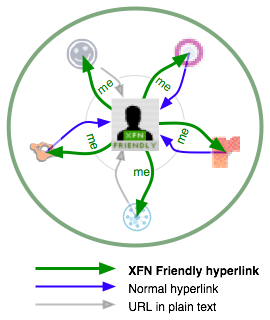 Use XFN rel="me" to unify your
Use XFN rel="me" to unify your  home page or blog and all your social networking site profiles into a consolidated identity.
home page or blog and all your social networking site profiles into a consolidated identity.XFN complements and interoperates with a plethora of services and technologies.This document explains how to use XFN with these services and technologies. In addition, guidelines and suggestions are provided for developers wishing to aggregate and merge explicit XFN relationships and implicit XFN relationships determined from centralized social networking sites.
In the past few years, quite a few "social networking" websites have emerged, which have many aspects in common. Each prvoides a web page (typically called a "profile" page) which represents a particular personand a hyperlinked list of their contacts or friends. When contacts and friends are added, they are in turn automatically encouraged to join the site and further its growth.
After two or three of these sites were launched, even their most eager users began to complain about having to re-enter their information over and over.In addition to the inefficiency of data re-entry (which some are attempting to alleviate with import/export functionality), there is the problem of synchronization across all these different sites — when you change some information about yourself or add a friend on one site, it becomes quite a hassle to update all the other sites.Finally, perhaps the biggest problem with such centralized social networking sites is that they are all islands unto themselves. There is no way to make an explicit (and for that matter, with proper authority) statement that a specific page on each of these sites actually represents the same person.
rel="me" valueXFN presents a simple and easy solution for this identity consolidation problem, with the new "me" value in XFN 1.1.
 Use XFN rel="me" to unify your
Use XFN rel="me" to unify your  home page or blog and all your social networking site profiles into a consolidated identity.
home page or blog and all your social networking site profiles into a consolidated identity.A user with an XFN Friendly blog, blogroll, or web site, can use that site as a nexusfor linking together all these otherwise disparate and isolated social networking sites, by linking from those sites to their blog, and then linking from their blog to their particular page(s) on each such centralized social networking site.
Since such sites typically do not allow editing the "rel" attribute of a user's pages, this usage introduces a special case for handling the "me" value. For sites that allow you to enter a URL or home page or blog URL as part of a person's profile page,the "me" relationship can be confirmed with a bidrectional link, where the link to those domains has a rel="me" attribute, even though the link from those centralized social networking domains does not have a rel="me" attribute.
This works because the ability to create each of those links, and thus point those pages at each other, demonstrates that the same person has control over them, and thus can declare that those pages represent the same person.
Here are brief instructions for editing your profile page on a few of these sites accordingly:
rel="me" relationship to a Friendster profile. Perhaps we could adopt the "Affiliations: " field as a defacto place for storing a plain text home page or blog URL? rel="me" relationship to a Linkedin profile. Perhaps we could adopt the "Interests: " field as a defacto place for storing a plain text home page or blog URL?Although perhaps originally intended as closed and/or proprietary systems, it is possible to spider the various centralized social networking sites' lists of links to people, and infer XFN relationships between them based upon the specific site. In some cases site-specific relationship details can be used to infer more specific XFN relationships.
Note: these suggestions are provided for the purpose of discussion, and anybody actually developing such spidering tools should read, respect, and comply with the terms of service of the site(s) their tools intend to spider.
Here is a list of centralized social networking sites, along with suggestions for how their implied relationship lists could be interpreted in terms of XFN.
rel="me" XFN relationship.Profile.aspx?uid URLs, and translate according to this table: | Orkut relationship | equivalent XFN value |
|---|---|
| haven't met | contact |
| acquaintance | acquaintance |
| friend | friend |
| good friend | |
| best friend |
rel="acquaintance", since none of them has never attempted to distinguish friends vs. acquaintances.Their effective "Are you my friend yes or no?" protocol has encouraged a lower barrier/critera for "Friendster friends" (aka "friendsters"), thus it makes sense for their notion of "friend" to be interpreted more as "aquaintance".rel="contact". Testimonials by current co-workers imply an XFN rel="co-worker" relationship as well.